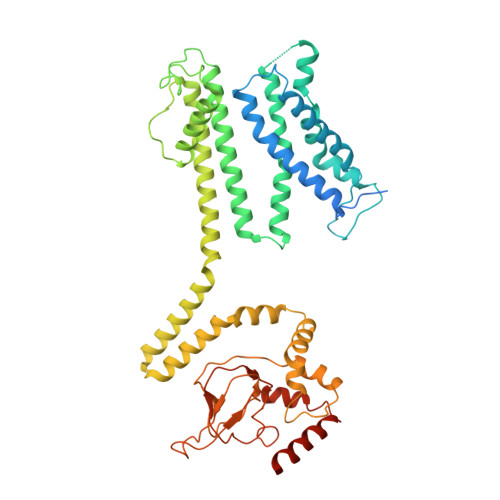Electromechanical coupling in the hyperpolarization-activated K + channel KAT1.
Clark, M.D., Contreras, G.F., Shen, R., Perozo, E.(2020) Nature 583: 145-149
- PubMed: 32461693
- DOI: https://doi.org/10.1038/s41586-020-2335-4
- Primary Citation of Related Structures:
6V1X, 6V1Y - PubMed Abstract:
Voltage-gated potassium (K v ) channels coordinate electrical signalling and control cell volume by gating in response to membrane depolarization or hyperpolarization. However, although voltage-sensing domains transduce transmembrane electric field changes by a common mechanism involving the outward or inward translocation of gating charges 1-3 , the general determinants of channel gating polarity remain poorly understood 4 . Here we suggest a molecular mechanism for electromechanical coupling and gating polarity in non-domain-swapped K v channels on the basis of the cryo-electron microscopy structure of KAT1, the hyperpolarization-activated K v channel from Arabidopsis thaliana. KAT1 displays a depolarized voltage sensor, which interacts with a closed pore domain directly via two interfaces and indirectly via an intercalated phospholipid. Functional evaluation of KAT1 structure-guided mutants at the sensor-pore interfaces suggests a mechanism in which direct interaction between the sensor and the C-linker hairpin in the adjacent pore subunit is the primary determinant of gating polarity. We suggest that an inward motion of the S4 sensor helix of approximately 5-7 Å can underlie a direct-coupling mechanism, driving a conformational reorientation of the C-linker and ultimately opening the activation gate formed by the S6 intracellular bundle. This direct-coupling mechanism contrasts with allosteric mechanisms proposed for hyperpolarization-activated cyclic nucleotide-gated channels 5 , and may represent an unexpected link between depolarization- and hyperpolarization-activated channels.
Organizational Affiliation:
Department of Biochemistry and Molecular Biology, The University of Chicago, Chicago, IL, USA.
















